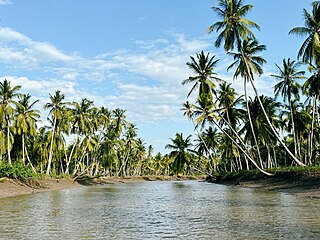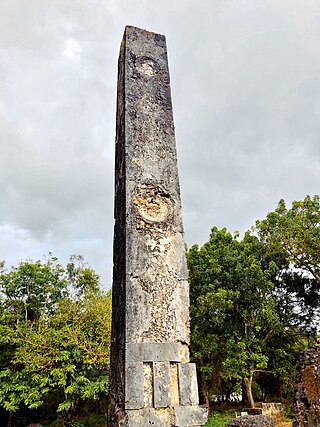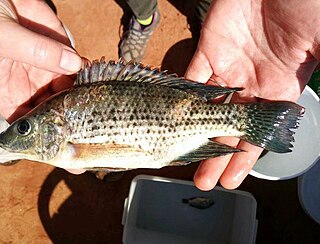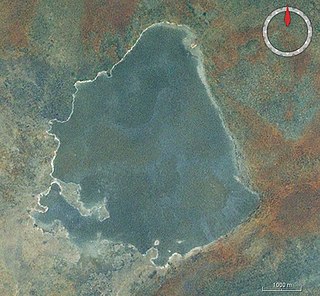Rhapta was an emporion said to be on the coast of Southeast Africa, first described in the 1st century CE. Its location has not been firmly identified, although there are a number of plausible candidate sites. The ancient Periplus of the Erythraean Sea described Rhapta as "the last emporion of Azania", two days' travel south of the Menouthias islands. The Periplus also states that the city and port were ruled by South Arabian vassals of the Himyarite kingdom, particularly a certain “ Mapharitic chieftain.”

Pangani District Council is one of eleven administrative districts of Tanga Region in Tanzania. The District covers an area of 1,756 km2 (678 sq mi). It is bordered to the north by Muheza District, to the east by Zanzibar Channel, to the south by the Chalinze District of Pwani Region, and to the west by the Handeni District. The district is comparable in size to the land area of Guadeloupe. The district seat (capital) and largest settlement in Pangani district is the town of Pangani. The district is named after the historic Pangani River. As of the 2012 census, the population was Pangani district was 54,025, making it the least populous district in Tanga Region.

The Tongoni Ruins are a 15th century Swahili ruins of a mosque and forty tombs located in Tongoni ward in Tanga District inside Tanga Region of Tanzania. The largest and possibly most significant Swahili site in Tanzania is Tongoni, which is located 25 km north of the Pangani River. Overlooking Mtangata Bay, about forty standing tombs and a Friday mosque of the "northern" style occupy a third of a hectare. People from the area continue to worship there spiritually. They bury their departed family members to the south of the historic tombs. The area was a different place four to five centuries ago. Contrary to its almost unnoticed presence today, it was a prosperous and a respected Swahili trading centre during the 15th century. Most of the ruins are still not yet been uncovered. The site is a registered National Historic Site.

Nyumba ya Mungu Dam is a Tanzanian, hydroelectric dam located in and operated in Mwanga District, Kilimanjaro Region. It was built in the late 1960s and is Kilimanjaro region's largest artificial water body. Nyumba ya Mungu Reservoir. The reservoir is shared with Moshi District of Kilimanjaro Region and Simanjiro District of Manyara Region. Nyumba ya Mungu means 'House of God'. Its installed capacity is 8 megawatts (11,000 hp).

The Pangani suckermouth is a species of upside-down catfish native to Kenya and Tanzania. This species grows to a length of 7 centimetres (2.8 in) SL.

Oreochromis esculentus, the Singida tilapia or Graham's tilapia, is a species of cichlid endemic to the Lake Victoria basin, including some of its satellite lakes such as Kyoga, in Tanzania, Uganda, and Kenya. Its common name refers to Lake Singida, but this population is the result of an introduction that happened in the 1950s. This fish is highly valued by local fishermen, who know it as ngege.

Oreochromis jipe, the Jipe tilapia, is a critically endangered species of cichlid fish native to Kenya and Tanzania, where it is restricted to Lake Jipe and the Pangani River. The population in the Pangani River shows some morphological differences compared to the population in Lake Jipe, and it is sometimes recognized as a separate species, the Pangani tilapia. Whether regarded as one or two species, the Jipe–Pangani tilapia forms a species flock with the threatened Lake Chala tilapia from the same general region of Kenya and Tanzania.
The Pangani robber is a species of fish in the family Alestidae. It is found in the Pangani River drainages, including Lake Jipe, in Tanzania and Kenya. Its natural habitats are rivers and lagoons.

Pangani is a historic town and capital of Pangani District in the Tanga Region of Tanzania. The town lies 45 km (28 mi) south of the city of Tanga, at the mouth of the Pangani River in which the town is named after. Administrately the town Pangani is situated within two wards, Pangani Mashariki and Pangani Magharibi. The town is currently the largest settlement in Pangani District and is a major tourist attraction in Tanga region and is a home to Muhembo, a Tanzanian National Historic Site.

Lake Ambussel is a lake on the Lossogonoi Plateau in Tanzania. Along with Nyumba ya Mungu Reservoir, Lake Chala and Lake Jipe, it is one of four waterbodies in the Pangani basin.

Lake Jipe is an inter-territorial lake straddling the borders of Kenya and Tanzania. On the Kenyan side, it is located south of the village of Nghonji while on the Tanzanian side, it is situated within Mwanga District, in Kilimanjaro Region. The lake is fed mainly by the Lumi River, which descends from Mount Kilimanjaro, as well as streams from the North Pare Mountains, being on the leeward side. The lake's outlet forms the Ruvu River. Kenya's unfenced Tsavo West National Park protects part of the lake's northern shore, while on the Tanzania side Mkomazi Game Reserve is nearby. The lake is known for its endemic fish, as well as water birds, mammals, wetland plants and lake-edge swamps, which can extend 2 kilometres (1.2 mi) from Jipe's shore.
The River Lumi is located in Rombo District, Kilimanjaro in northereast Tanzania and a small part in southern Kenya in Coast Province. It originates on the east side of Mawenzi peak on the east side of, and flows so close to the River Rombo as almost to form a fork. The Lumi, however, maintains its southerly direction, and may thus be said to represent the upper course of the Ruvu, one of tho two main sources of the Pangani River. It flows around the Lake Chala and the Taveta town in the west and empties into the Lake Jipe. The fish species Barbus sp. 'Pangani' has only been found in the river's N'joro Springs, situated in the upper Pangani River drainage basin.

The Pangani River, is a major river of northeastern Tanzania. It has two main sources: the Ruvu, which rises as Lumi at Kilimanjaro, passes through Lake Jipe, and empties into the Nyumba ya Mungu Reservoir, and the Kikuletwa River, coming from the west and mainly fed by rivers of Mount Meru in Arusha Region, which also enters into the Nyumba ya Mungu Reservoir in Kilimanjaro Region. Just after leaving the reservoir the stream becomes the main Pangani, which empties into the Indian Ocean in Tanga Region at the Tangan port town of Pangani.
Muhembo is a Swahili monumental ruin that is National Historic Site located in northern part of Pangani town's Pangani Mashariki ward in Pangani District of Tanga Region, Tanzania. The site is home to damaged Medieval Swahili ruins that have yet to be excavated since 1981. Other minor sites in the viciinity of Muhembo include; Gombero, Mtakani, Muhembo, Mnyongeni, and Kumbamtoni.

Pangani Mashariki is an administrative ward in Pangani District of Tanga Region in Tanzania. The ward cover the eastern part of Pangani Town. The ward is also the seat of the district capital, with the district council building located in the north of the ward. Pangani mashariki is one of 13 wards in Pangani District as of 2012. The ward covers an area of 13 km2 (5.0 sq mi), and has an average elevation of 37 m (121 ft).
Amphilius krefftii is a species of catfish in the genus Amphilius. It is found in the Galana River basin in Kenya, and the Sigi River, Pangani River, and Lake Jipe basins in Tanzania. Its length reaches 20.8 cm.
Kikuletwa River is located in the northern Kilimanjaro Region, Manyara Region and eastern Arusha Region of Tanzania. It begins in Songoro ward in Meru District, Arusha and eventually drains into Pangani River at Nyumba ya Mungu Dam. The Kikuletwa hot springs also drain into the river.











